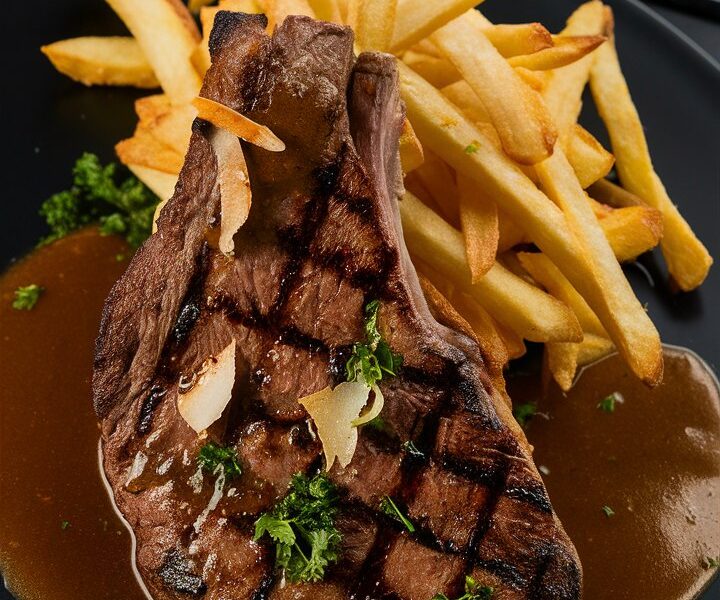There is a certain kind of magic in preparing a steak at home. The sound of sizzling beef hitting a hot cast iron pan, the aroma of butter mingling with garlic and rosemary, and the satisfaction of slicing into a perfectly seared piece of meat — all of it creates an experience that rivals any steakhouse dinner.
This article is more than just a recipe. It’s a complete guide to cooking Pan Seared New York Strip Steak, covering everything from ingredient selection to doneness levels, serving ideas, storage tips, and even the cooking science behind that golden-brown crust. Whether you’re an enthusiastic beginner or a home chef refining your craft, this step-by-step resource ensures that your steak comes out tender, juicy, and flavorful every single time.
Why This Recipe Works
Cooking steak at home can feel intimidating, but it doesn’t have to be. By following a few key principles, you can achieve results that are consistently outstanding. Here’s why this recipe delivers:
- Crispy crust, juicy center – Achieved by using high heat to form a crust that locks in juices.
- Garlic butter finish – Luxurious flavor that elevates without masking the beef.
- No marinade required – Let the natural taste of quality beef shine with just salt and pepper.
- Restaurant-style experience – All you need is one skillet and a handful of ingredients.
- Adaptable doneness – From rare to well-done, you’re in control of how you like it.
Unlike overly complex recipes, this method is elegant but approachable, making it perfect for both weeknight meals and special occasions.
Choosing the Best New York Strip Steak
The success of this dish begins with choosing the right cut. A New York Strip is prized for its balance of tenderness and robust beefy flavor. Here’s what to look for at the butcher or grocery store:
- Thickness – Ideally at least 1¼ to 1½ inches thick for even cooking.
- Marbling – Fine white streaks of fat within the meat; more marbling means juicier steak.
- Color – Look for a vibrant red hue, not dull or brown.
- Freshness – A clean, meaty aroma, never sour or overly strong.
👉 Tip: If New York Strip isn’t available, ribeye or top sirloin can be excellent substitutes using the same cooking technique.
Ingredients Breakdown
Every ingredient in this recipe plays a role. Let’s break it down:
- New York Strip Steaks (about 1 lb each): The star of the dish.
- Sea Salt & Black Pepper: Essential for enhancing natural flavors.
- High-Heat Oil (vegetable, canola, or avocado oil): Creates a strong sear without burning.
- Unsalted Butter: Adds richness; unsalted allows you to control salt levels.
- Garlic Cloves: Infuses the butter with subtle aromatics.
- Fresh Rosemary or Thyme: Optional, but creates a restaurant-quality aroma.
- Cast Iron Skillet: The best tool for retaining high heat and achieving a deep crust.
Step-by-Step Cooking Instructions
Step 1: Prep the Steaks
- Remove steaks from the refrigerator about 20–30 minutes before cooking.
- Pat dry thoroughly with paper towels — moisture prevents proper searing.
- Season generously with salt and pepper on both sides.
Step 2: Heat the Skillet
- Place a cast iron skillet over medium-high heat.
- Once hot, add oil and swirl to coat the surface.
Step 3: Sear the Steaks
- Lay the steaks in the pan without crowding.
- Cook undisturbed for 4 minutes on the first side.
- Flip and sear for another 3–4 minutes.
- Sear edges and fat cap by holding steaks with tongs.
Step 4: Butter Basting
- Lower heat slightly.
- Add butter, garlic, and rosemary to the pan.
- Tilt pan slightly and spoon melted butter over the steak repeatedly for 1–2 minutes.
Step 5: Check Doneness
- Rare: 120–125°F
- Medium-rare: 130–135°F
- Medium: 140–145°F
- Medium-well: 150–155°F
- Well done: 160°F+
Step 6: Rest and Serve
- Transfer steaks to a cutting board, tent loosely with foil.
- Rest for 10 minutes to let juices redistribute.
- Slice against the grain and drizzle with pan butter.
Common Mistakes to Avoid
- Cooking straight from the fridge – Cold steaks cook unevenly.
- Overcrowding the skillet – Causes steaming instead of searing.
- Flipping too often – Let the crust develop before turning.
- Skipping the rest – Cuts juices loose and dries the steak.
What to Serve With New York Strip Steak
A steakhouse-worthy meal deserves complementary sides. Consider:
- Garlic Mashed Potatoes – Creamy, buttery, perfect for soaking up juices.
- Roasted Asparagus with Parmesan – Adds freshness and crunch.
- Caesar Salad – A light, crisp counterbalance.
- Dinner Rolls or Crusty Bread – Essential for garlic butter drippings.
- Wine Pairings – Cabernet Sauvignon or Malbec for richness; Pinot Noir for lighter balance.
Variations & Substitutions
- Herbs: Swap rosemary for thyme, sage, or a mix.
- Butter Alternatives: Use ghee or herb-infused oils.
- Cuts of Beef: Ribeye (richer), filet mignon (tender), or sirloin (budget-friendly).
- Diet-Friendly:
- Keto/Low-Carb: Pair with sautéed spinach or cauliflower mash.
- Dairy-Free: Replace butter with avocado oil.
- Whole30: Skip butter and use clarified ghee.
Storage & Reheating Tips
- Refrigerator: Store in an airtight container for up to 3 days.
- Freezer: Wrap tightly in foil + freezer bag for up to 2 months.
- Reheat Gently: Warm in a skillet with butter on low heat or in a 300°F oven.
- ❌ Avoid microwaving — it ruins texture.
👉 Leftover ideas: Steak sandwiches, grain bowls, tacos, or steak salads.
FAQs About Pan Seared New York Strip Steak
- Do I need a cast iron skillet?
– Not mandatory, but it delivers the best crust. Stainless steel is a good backup. - Why not use butter for initial searing?
– Butter burns at high heat; use oil first, then add butter later. - How long should steak rest?
– At least 8–10 minutes for juices to redistribute. - Can I marinate this steak?
– You can, but it’s not necessary. This cut is flavorful on its own. - How do I get a steakhouse-style crust?
– Pat steak dry, use high heat, and don’t flip too soon. - What’s the best thickness?
– 1½ inches is ideal for even cooking. - Can I grill instead of pan-sear?
– Yes, same seasoning works beautifully on the grill. - How do I prevent smoke?
– Use proper ventilation, don’t overcrowd, and avoid low smoke-point oils. - Can I add mushrooms or onions?
– Yes, sauté them in the pan juices for a flavorful side. - Is this recipe suitable for meal prep?
– Yes, but best eaten fresh. Reheating tips above apply.
Nutrition & Health Benefits
- Protein: Builds muscle, keeps you satisfied.
- Iron & Zinc: Supports energy and immunity.
- Healthy Fats: Especially if using grass-fed beef.
- Moderation Matters: Steak is nutrient-dense but should be balanced with vegetables.
Cooking Science Behind Pan-Seared Steak
The secret to great steak lies in the Maillard reaction — a chemical process that happens when meat proteins and sugars interact under high heat. This creates the brown, crusty exterior and complex, savory flavor that steak lovers crave.
Butter basting works because fat carries flavor compounds, and spooning it over the steak ensures even coating. Garlic and rosemary release oils into the butter, infusing every bite with aromatic depth.
Final Thoughts
Cooking a Pan Seared New York Strip Steak at home is not just about feeding yourself — it’s about creating a memorable experience. With minimal ingredients, a single skillet, and a bit of patience, you can enjoy a steakhouse-worthy dinner without stepping outside.
From selecting the right cut to nailing doneness, from butter-basting to pairing with the perfect side dish, this guide has walked you through every detail. The next time you crave a luxurious meal, skip the reservations and trust your skillet.
Your table, your rules — and now, your steakhouse-quality dinner.





